Ayutthaya. A city shrouded in mystery to most of the West. Despite being one of the largest trading ports in Southeast Asia, and capital of Siam until 1767, most Westerners would probably never know what you were talking about. Home of kings and the locus of power for much of the Chao Phraya river valley, it was long forgotten by outsiders, who from the latter half of the 18th century rarely went beyond the new Siamese capital of Bangkok. Even the local Thai put it aside, and have only recently begun to see the ruined temples and palace grounds as an important part of their cultural heritage.
Our journey to the ancient capital of central Thailand began in the modern capital--Bangkok. We started out of the Shangri-La hotel for the ride up to Ayutthaya. On our way up, our guide gave us some brief notes about the Ayutthaya period, though there was also time to catch up on a little lost sleep for those of us who got up earlier than usual.
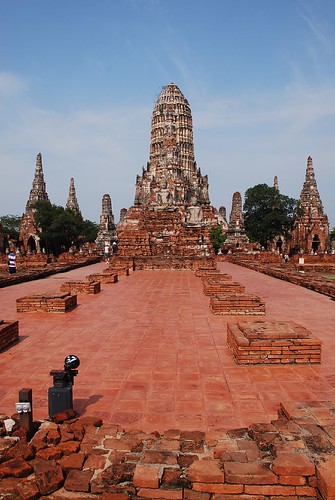
We first stopped on the west bank of the Chao Phraya river, across from the ancient city of Ayutthaya, at Wat Chai Wattanaram. This ancient temple is in the Khmer style, and was the model for Wat Arun in Bangkok. Prior to Thai dominance, the area of Ayutthaya was under Khmer control, but as their grip loosened, the Thai people formed their own independent polities, with Ayutthaya as one of the capital cities. Ayutthaya continued to vie with the Khmer kingdom in Cambodia, and Wat Chai Wattanaram was built in 1630 by King Prasat Thong to celebrate a victory over the Khmer.

One prominent feature of the Khmer style Buddhist temples is this central prang--the prominent 'mountain' in the center.
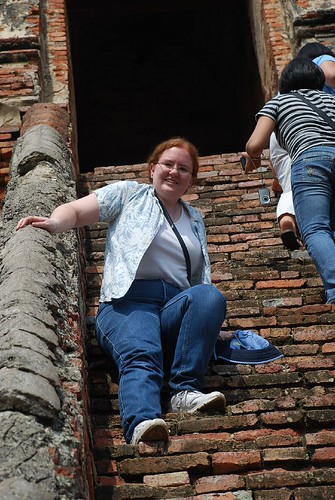
...It is definitely easier going up than down. If only because when you are going up you don't have to look down.
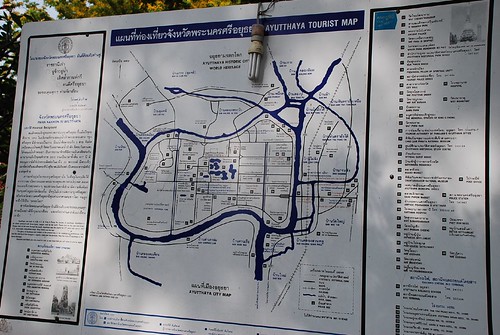
Situated at the confluence of several rivers, with the Chao Phraya leading out to the sea, this was an important place for trade. In addition, the rivers provided a natural defense. By digging a single channel the city was made into an island. Furthermore, smaller canals were dug to provide both irrigation and transportation; most Thai houses of the time had one side facing the water and the other facing the land, and boats were one of the most common forms of transportation.

Despite its defensive position, Ayutthaya finally fell to the Burmese in 1767. Although it had suffered defeat before, this time the Burmese wanted to remove it as a threat, permanently. All that is left of the Grand Palace are these foundations. When the Siamese fled the Burmese invasion, they created a copy of the Grand Palace, first on the west bank of the Chao Phraya at Thonburi, and then again when they moved across the river to Bangkok. At that time, they also came up to Ayutthaya and removed stones from the wall that had once surrounded the city to help rebuild the capital in its new location.
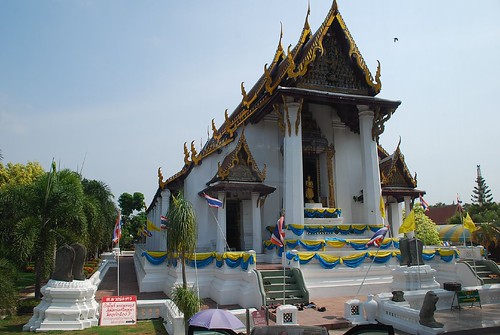
The only temple that survives intact from the Ayutthaya period is Wat Na Pramain (or Wat Na Prameru Rachikaram). The Burmese general used this as his headquarters, and so it was spared the fate of most of the 400 some-odd temples recorded within the city limits.
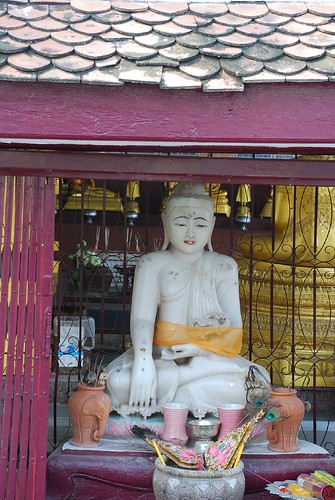
When the Burmese left, they also left behind an image of the Buddha in the Burmese style. The current image is actually a reproduction to replace the original. It is generally assumed that people make statues of the Buddha in their own image, and this is how many connoisseurs determine a statue's provenance.
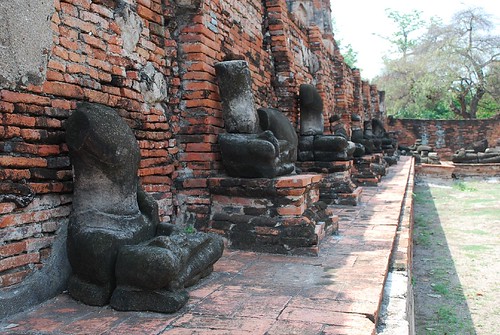
The last place we visited on the island of Ayutthaya was Wat Maha That. Also built in the Khmer style, it is said to have been started in 1374. During its heyday it was the temple of the Supreme Patriarch--the highest ranking Bhuddhist priest in the country. After the fall of Ayutthaya to the Burmese, it was ruined, and in the later centuries it was vandalized by people who would cut the hands and heads off the Buddha images to sell to tourists and antique dealers.
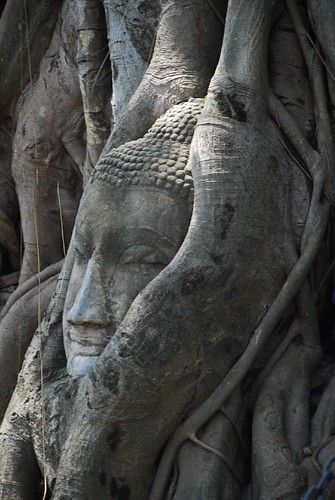
The fate of one head was not to be sold. While it is unclear exactly what happened, this head was apparently left by vandals after it had been cut off. The roots of the Bhodi tree then closed around it, and now it is one of the more popular symbols of Thailand and Ayutthaya in particular.
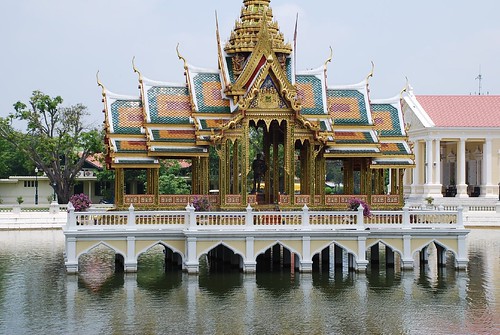
From the island of Ayutthaya we traveled south, past the sites of the old Dutch and Japanese settlements, to the Summer Palace. This is still a Royal Palace, and it was built by King Rama V of the current Chakri dynasty. This pavillion is the only fully Thai building on the property. Other buildings are inspired by mostly European architecture.

The crown jewel of the Summer Palace is supposed to be this Chinese palace--built by Chinese immigrants for the King. While it is impressive, it was almost too much, and I think I preferred the more sedate Western style buildings, which I felt had a more stately elegance.
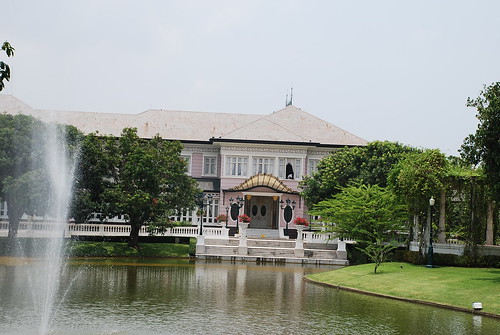
Personally, I found the Western style buildings, such as this stately Italian influenced mansion, to be more elegant. Perhaps it is simply an ethnocentric preference for European buildings--though I think it has more to do with the Chinese palace just being too busy. I find I occasionally have the same issue with the aesthetics of Thai temples--though as I grow more accustomed to them I find them not quite so jarring. Perhaps it is just that my mind is no longer being overloaded in an attempt to classify all of the 'new' information and is coming to grips with the style in general.
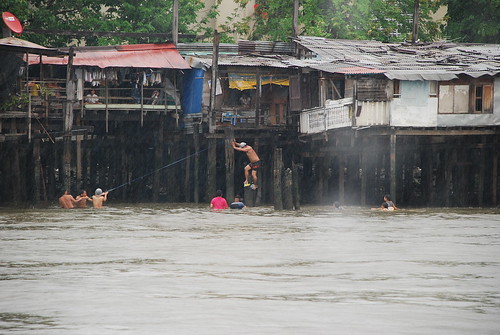
We got on the boat just in time--as we were eating lunch on the boat, the skies opened up and it began to rain. Despite the wetness, there were still people out working, however, such as this scene we captured floating downriver.
It is truly amazing how many people live along the river, which can rise as much as 20 feet when it floods. It is also amazing just what kind of engineering went into it to straighten out some of the curves, providing 'shortcuts' that turn a half-hour into five minutes. I still wonder how they did it.
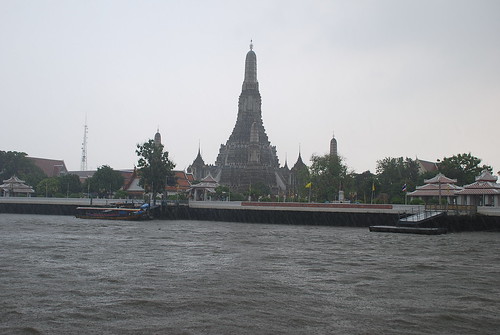
The towering prang of Wat Arun indicated we were almost home. Soon we would alight at the Shangri-La dock, head over to the BTS Skytrain station at Saphon Taksin, and ride home. The rain had lifted, and we were able to give some thought to the trip. Overall, it was well worth it--for a day trip, it was quite reasonable, and well organized. We definitely plan to head up, again, to Ayutthaya--there is still too much history there for us not to go back. There are museums and temples to visit, not to mention several towns nearby that are still known for producing traditional products, such as swords and the like. Plenty to keep us busy for many weekends to come!


We first stopped on the west bank of the Chao Phraya river, across from the ancient city of Ayutthaya, at Wat Chai Wattanaram. This ancient temple is in the Khmer style, and was the model for Wat Arun in Bangkok. Prior to Thai dominance, the area of Ayutthaya was under Khmer control, but as their grip loosened, the Thai people formed their own independent polities, with Ayutthaya as one of the capital cities. Ayutthaya continued to vie with the Khmer kingdom in Cambodia, and Wat Chai Wattanaram was built in 1630 by King Prasat Thong to celebrate a victory over the Khmer.

One prominent feature of the Khmer style Buddhist temples is this central prang--the prominent 'mountain' in the center.

...It is definitely easier going up than down. If only because when you are going up you don't have to look down.

Situated at the confluence of several rivers, with the Chao Phraya leading out to the sea, this was an important place for trade. In addition, the rivers provided a natural defense. By digging a single channel the city was made into an island. Furthermore, smaller canals were dug to provide both irrigation and transportation; most Thai houses of the time had one side facing the water and the other facing the land, and boats were one of the most common forms of transportation.

Despite its defensive position, Ayutthaya finally fell to the Burmese in 1767. Although it had suffered defeat before, this time the Burmese wanted to remove it as a threat, permanently. All that is left of the Grand Palace are these foundations. When the Siamese fled the Burmese invasion, they created a copy of the Grand Palace, first on the west bank of the Chao Phraya at Thonburi, and then again when they moved across the river to Bangkok. At that time, they also came up to Ayutthaya and removed stones from the wall that had once surrounded the city to help rebuild the capital in its new location.

The only temple that survives intact from the Ayutthaya period is Wat Na Pramain (or Wat Na Prameru Rachikaram). The Burmese general used this as his headquarters, and so it was spared the fate of most of the 400 some-odd temples recorded within the city limits.

When the Burmese left, they also left behind an image of the Buddha in the Burmese style. The current image is actually a reproduction to replace the original. It is generally assumed that people make statues of the Buddha in their own image, and this is how many connoisseurs determine a statue's provenance.

The last place we visited on the island of Ayutthaya was Wat Maha That. Also built in the Khmer style, it is said to have been started in 1374. During its heyday it was the temple of the Supreme Patriarch--the highest ranking Bhuddhist priest in the country. After the fall of Ayutthaya to the Burmese, it was ruined, and in the later centuries it was vandalized by people who would cut the hands and heads off the Buddha images to sell to tourists and antique dealers.

The fate of one head was not to be sold. While it is unclear exactly what happened, this head was apparently left by vandals after it had been cut off. The roots of the Bhodi tree then closed around it, and now it is one of the more popular symbols of Thailand and Ayutthaya in particular.

From the island of Ayutthaya we traveled south, past the sites of the old Dutch and Japanese settlements, to the Summer Palace. This is still a Royal Palace, and it was built by King Rama V of the current Chakri dynasty. This pavillion is the only fully Thai building on the property. Other buildings are inspired by mostly European architecture.

The crown jewel of the Summer Palace is supposed to be this Chinese palace--built by Chinese immigrants for the King. While it is impressive, it was almost too much, and I think I preferred the more sedate Western style buildings, which I felt had a more stately elegance.

Personally, I found the Western style buildings, such as this stately Italian influenced mansion, to be more elegant. Perhaps it is simply an ethnocentric preference for European buildings--though I think it has more to do with the Chinese palace just being too busy. I find I occasionally have the same issue with the aesthetics of Thai temples--though as I grow more accustomed to them I find them not quite so jarring. Perhaps it is just that my mind is no longer being overloaded in an attempt to classify all of the 'new' information and is coming to grips with the style in general.

We got on the boat just in time--as we were eating lunch on the boat, the skies opened up and it began to rain. Despite the wetness, there were still people out working, however, such as this scene we captured floating downriver.
It is truly amazing how many people live along the river, which can rise as much as 20 feet when it floods. It is also amazing just what kind of engineering went into it to straighten out some of the curves, providing 'shortcuts' that turn a half-hour into five minutes. I still wonder how they did it.

The towering prang of Wat Arun indicated we were almost home. Soon we would alight at the Shangri-La dock, head over to the BTS Skytrain station at Saphon Taksin, and ride home. The rain had lifted, and we were able to give some thought to the trip. Overall, it was well worth it--for a day trip, it was quite reasonable, and well organized. We definitely plan to head up, again, to Ayutthaya--there is still too much history there for us not to go back. There are museums and temples to visit, not to mention several towns nearby that are still known for producing traditional products, such as swords and the like. Plenty to keep us busy for many weekends to come!


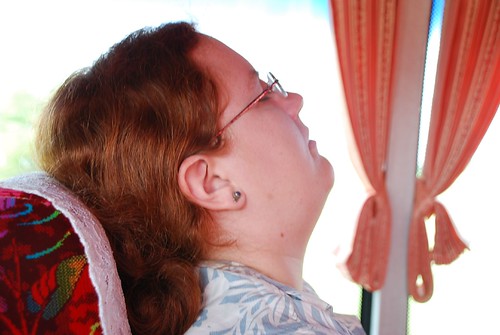
No comments:
Post a Comment